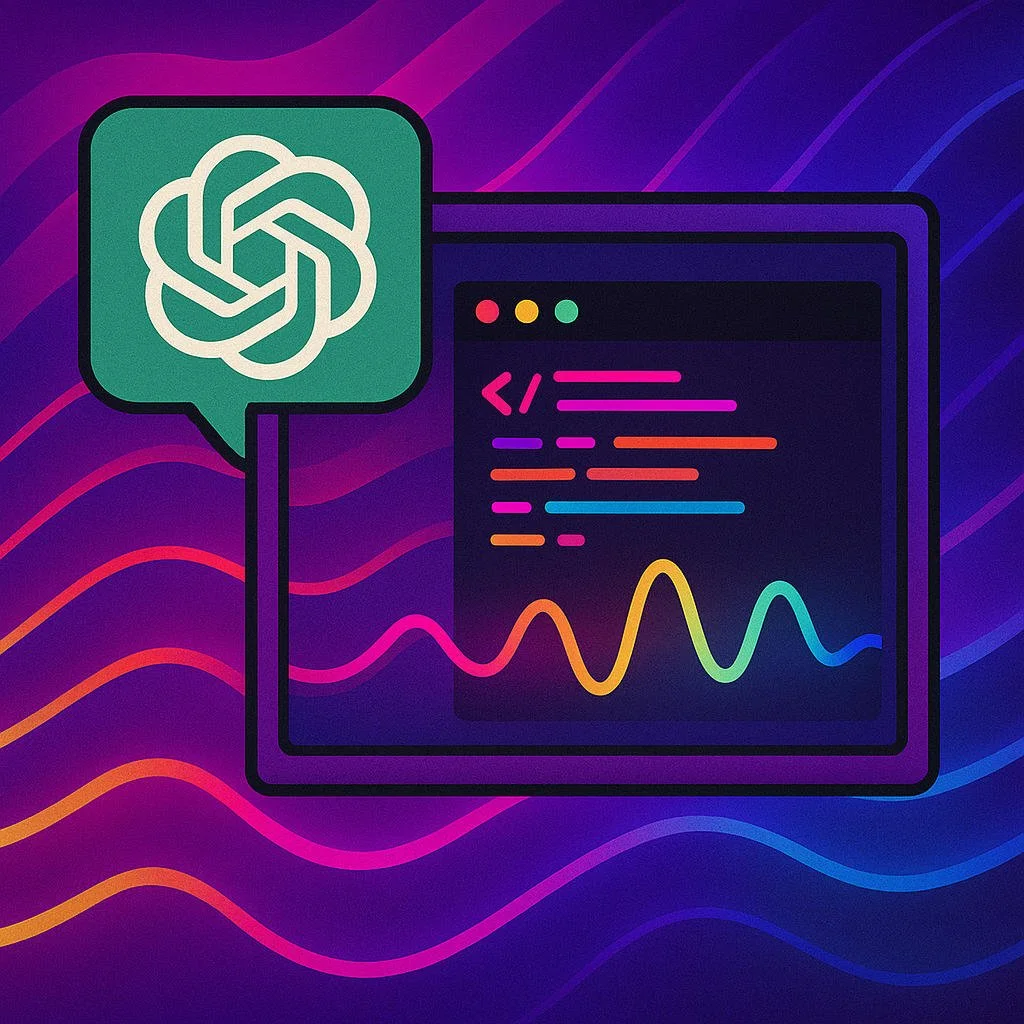How to Use ChatGPT to Vibe Code (Without Shipping a Total Disaster)
What “vibe coding” actually is
“Vibe coding” is the new slang for a style of programming where you describe what you want in natural language and let an AI (like ChatGPT) generate most or all of the code. You focus on ideas, goals, and feedback, not on manually writing every line.
In its purest definition, vibe coding means:
You describe the project in English
The AI writes the code
You mostly interact via prompts and test results, not by editing code line-by-line
You iterate by saying things like “It crashed, here’s the error, please fix it”
It got popularized by Andrej Karpathy and ended up as a word-of-the-year finalist because it captures this shift: English is the new programming language, and AI is your runtime translator.
This guide is basically: How to vibe code using ChatGPT, but with enough structure that you don’t accidentally vibe your way into a flaming dumpster of bugs and security holes.
Where ChatGPT fits into vibe coding
With ChatGPT, you can:
Describe the app you want (“a little web app that tracks my workouts and graphs progress”)
Pick a stack (React, Python, Node, etc.) or ask ChatGPT to choose for you
Generate full files (HTML, CSS, backend, tests)
Iterate based on error messages and behavior (“when I click this button nothing happens”)
Refactor and extend the project with new features using conversational prompts
You’re basically moving from “typing code” to “designing and debugging through conversation.”
Step 1: Start with a strong “vibes specification”
Vibe coding doesn’t mean “say something vague and pray.” You still need a clear, high-level spec—just in human language.
When you start a new project, give ChatGPT a prompt like this:
I want to build a small web app using [tech stack, e.g., React + Node + SQLite].
Purpose: [e.g., a simple meal planner that lets me add recipes and generate a grocery list].
Core features:
– [Feature 1]
– [Feature 2]
– [Feature 3]
Non-goals: [things it doesn’t need to do yet].
Constraints:
– Keep it simple and beginner-friendly.
– No external paid APIs.
– Code should run locally with minimal setup.First, restate your understanding of the project, choose a simple architecture, and list the files you plan to create. Don’t write code yet—just the plan.
You’re asking ChatGPT to design the app in plain English first. Once the plan feels right, you say:
Great. Now please generate the initial version of all the files you listed.
Boom: first pass of the project.
Step 2: Let ChatGPT choose or confirm the tech stack (or vibe within one)
You can either:
Tell it the stack you know (safer if you’ll maintain it):
“Use Python + Flask.”
“Use React + Vite + TypeScript.”
Or let it propose something:
“Recommend a simple stack for a beginner that supports [web / CLI / desktop] and explain why.”
Prompt example:
Suggest 2–3 tech stacks I could use for this project.
– I’m comfortable / not comfortable with JavaScript.
– I want the easiest setup on [Windows/macOS/Linux].
– I prefer [web app / CLI tool / desktop app].
For each option, briefly explain pros/cons. Then pick one as your recommendation.
Then you lock it in:
Let’s go with option 2. Use that stack for all code from now on.
Now all future vibe coding will be coherent instead of bouncing between stacks.
Step 3: Vibe your first prototype into existence
Once the plan and stack are set:
Please generate the initial code for this project.
– Include all core features we discussed.
– Provide each file separately with a filename header.
– After the code, give me step-by-step instructions to run it locally.
Copy the files into your editor, follow the run instructions, and… you’ll probably hit errors. That’s normal.
Step 4: “Vibe debugging” with ChatGPT (aka: paste your errors)
The meme is: vibe coding is easy, vibe debugging is hard.
Your job in this phase is basically:
Run the app
See what breaks
Paste the error and a short description back to ChatGPT
Prompt pattern:
I tried running the app and got this error:
[paste exact error trace]The file structure I have locally is:
[list files briefly]The behavior I expected: [describe]
The behavior I got: [describe]Please diagnose the problem and give me the updated code for only the files that need to change. Explain in 2–3 sentences what went wrong.
Then you:
Replace the updated files
Try again
Repeat the loop
You’re treating ChatGPT as your senior dev / rubber duck that can read stack traces and fix them.
Step 5: Iterate features using natural language
Once the prototype works, you start adding stuff by just talking to it.
Example:
The app works, but now I want to:
– Add user login with simple email + password (no social logins).
– Let each user have their own data so they don’t see each other’s stuff.
– Add a “dark mode” toggle.Update the architecture if needed and then modify the code. Show me only the changed files or the diff. Explain what you changed and where.
Good iteration prompts:
“Make the UI less ugly. Use a simple, modern layout, but keep dependencies minimal.”
“Add input validation: prevent empty fields and show error messages.”
“Make this mobile-friendly. Show me what CSS or layout changes you propose.”
You focus on intent and UX, ChatGPT handles the actual implementation.
Step 6: Use ChatGPT to generate tests and sanity checks
Pure vibe coding (in the strict definition) often means you don’t deeply review the code—which many experts warn is risky for anything serious.
A nice compromise: let ChatGPT generate tests and basic safety nets, even if you’re not reading every line.
Prompt:
Please write unit tests or integration tests for this project using [testing framework, e.g., Jest / pytest].
– Cover the main success paths and at least a couple of failure cases.
– Point out any parts of the code that are hard to test and why.
– If you see obvious refactors that would make testing easier, suggest them.
Even if you’re still mostly “vibing,” tests give you a red/green signal when stuff breaks.
Step 7: Let ChatGPT explain your own project back to you
If you want to stay in full “vibe mode” but still have some understanding, have ChatGPT summarize your code:
Based on the code you generated so far (I’ll paste the files below),
– Explain at a high level how the app works.
– Describe the data flow (what happens from user click to response).
– Point out any obvious performance or security issues I should be aware of.
– If any part is overly complex, suggest how to simplify it.
Paste files in chunks if needed.
This is like reading the CliffsNotes for your own codebase.
Step 8: Where vibe coding is great vs where it’s dangerous
Based on how the industry is reacting, there’s a rough consensus:
Vibe coding is GREAT for:
Weekend projects and experiments
“Software for one” — personal tools, hobby apps
UI prototypes and quick demos
Learning how systems might be wired together
Hackathons and pitch concepts
Vibe coding is RISKY for:
Security-sensitive systems (auth, payments, healthcare, finance)
Code that others will maintain long-term
Anything that needs strict compliance or auditability
Public libraries / packages that others depend on
Experts have warned that copying or deploying AI-generated code without proper review can introduce subtle bugs, security flaws, and maintainability nightmares.
So a sane rule of thumb:
Vibe code prototypes.
Review and harden anything that goes to production.
That “review and harden” can also be supported by ChatGPT:
Act as a security-conscious senior engineer.
I’ll paste parts of my app. For each:
– Point out potential security issues (injections, auth, unsafe input).
– Suggest concrete fixes.
– Flag anything that should not ship as-is.
Step 9: Sample vibe coding workflows with ChatGPT
A. Tiny web app: “Mood Journal”
Goal: A single-page app where you log your mood and see a simple chart.
Spec prompt:
Purpose, features (log mood 1–10, add notes, view history), simple chart.
Ask for React + a minimal backend (or even just localStorage).
Generation:
“Create all files and instructions to run.”
Iteration:
“Add filters by date range.”
“Add a ‘streak’ counter showing how many days I logged in a row.”
“Make the design soft and calming, with pastel colors.”
Testing:
“Write tests for mood logging and streak calculation.”
B. CLI tool: “Screenshot Organizer”
Goal: A command-line tool that scans a folder and groups screenshots by app or game name based on filename patterns.
Spec prompt:
Python, single script, input folder, output folders by pattern.
Generation & iteration:
“Add a dry-run mode that only prints what it would do.”
“Add a
--undooption to reverse the last run.”
Safety:
“Write tests for the file-moving logic and suggest ways to avoid accidental data loss.”
In both cases, you never hand-wrote the code; you just kept steering.
Step 10: Prompt recipes for better vibe coding with ChatGPT
You can copy-paste and customize these:
1. Start a new project
You are my AI coding partner. I want to vibe code a small project.
Project idea: [describe].
My skill level: [beginner/intermediate/advanced].
Target stack: [if any].Restate the idea.
Propose a simple architecture and file structure.
Then generate the initial version of all files and tell me how to run it locally.
2. Fix an error
I ran the code and got this error:
[paste error]Here is the relevant file:
[paste code]Explain what the error means in simple terms, then fix it. Show me the updated code and briefly explain what you changed.
3. Add a feature
The app works, and now I want this feature:
[describe feature clearly].Update the code to implement it.
– Show only the changed files or sections.
– Explain how the new feature works and how it interacts with existing code.
4. Refactor for readability
Please refactor this code for clarity and maintainability, without changing behavior.
– Use clear variable and function names.
– Reduce duplication.
– Add short comments where a future developer might be confused.Here is the code:
[paste code]
5. Generate tests
Write tests for the following functions/components using [framework].
– Cover normal cases and at least one failure or edge case each.
– After the tests, explain how to run them.Code:
[paste code]
Final thoughts
Using ChatGPT to vibe code is basically pair programming with an AI that does 95% of the typing:
You bring the idea, intent, and taste
ChatGPT brings the boilerplate, wiring, and iteration speed
You loop between “describe → run → fix” until it feels right
If you keep a few guardrails—tests, basic security awareness, and skepticism for serious projects—you can have a lot of fun and ship surprisingly real tools just by talking to your AI.
And if something explodes?
Well, that’s just the vibes telling you it’s time for another prompt.







